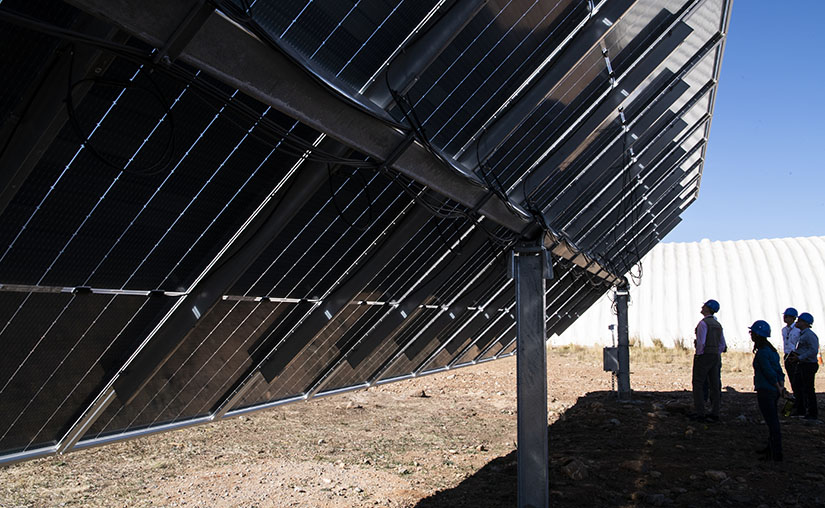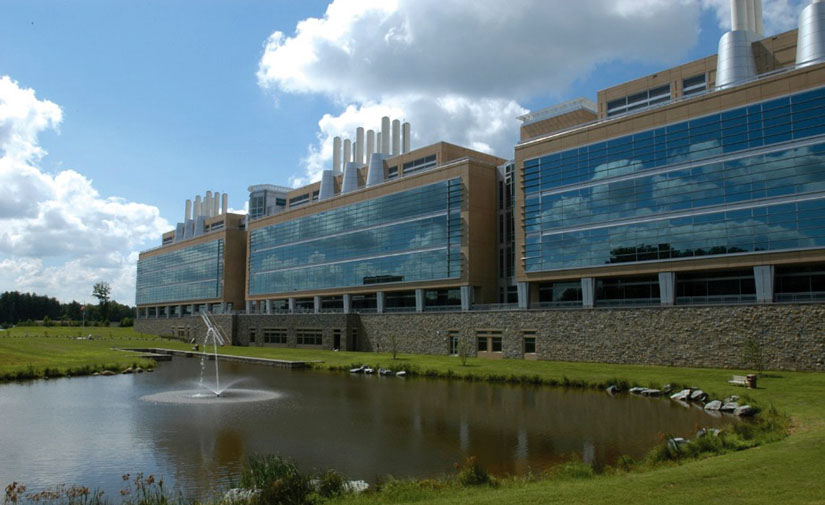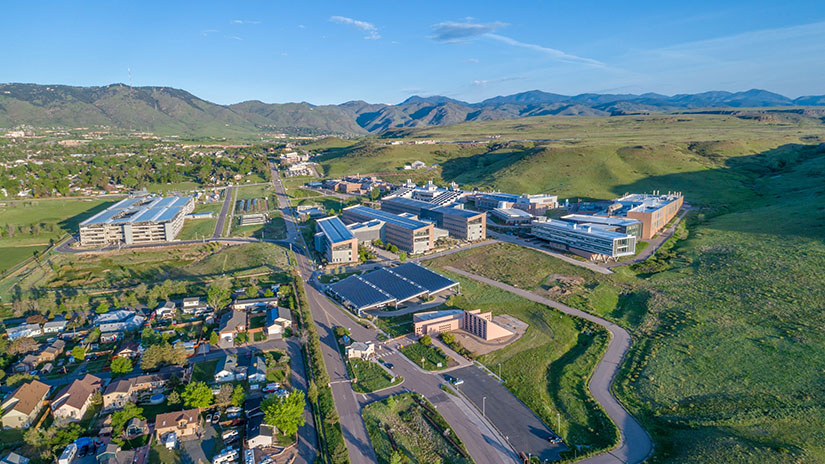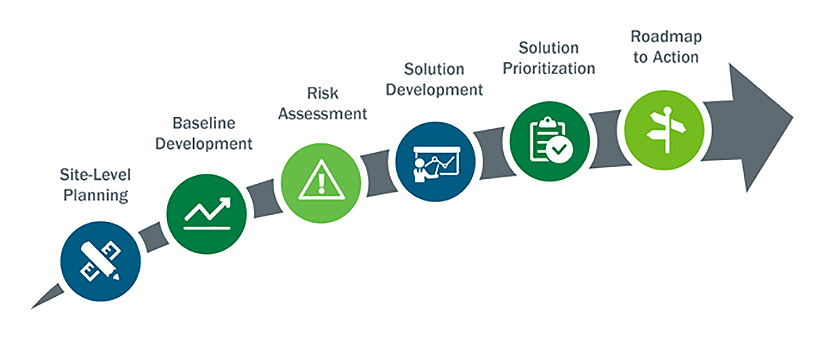Resilient and Ready: NREL Helps Large Federal Campuses Examine Their Energy and Water Posture
The Technical Resilience Navigator Prepares Federal Agencies for Smarter, Stakeholder-Informed Resilience Planning

Energy and water infrastructure resilience—the ability to prepare for and adapt to changing conditions and withstand and recover rapidly from disruptions―is front of mind for federal agencies around the country. The federal government owns or manages hundreds of thousands of federal buildings, and agencies have a vested interest in ensuring their buildings and energy and water infrastructure assets can withstand and recover from deliberate attacks, accidents, or naturally occurring hazards or incidents.
With a massive portfolio of diverse assets facing a wide range of potential natural hazards and man-made threats, federal agencies are calling on resilience planning experts at the National Renewable Energy Laboratory (NREL). Resilience planning helps organizations identify opportunities, prioritize funding, and develop a pipeline of projects to strengthen their operations against a range of hazards and threats. Increasing climate change impacts coupled with priorities such as electrification, decarbonization, and efficiency create the need for a systematic approach to resilience planning.
Resilience planning helps organizations identify opportunities, prioritize funding, and develop a pipeline of projects to strengthen operations against a range of threats.
To aid federal agencies in resilience planning, NREL researchers use the Technical Resilience Navigator (TRN)―a tool that leads users through a series of modules to build stakeholder engagement, an organizational assessment, and an actionable plan. The Federal Energy Management Program (FEMP) funded NREL and the Pacific Northwest National Laboratory to create the TRN, recognizing the need for risk-informed resilience planning to help organizations manage the risk to critical missions from disruptions in energy and water services.
The TRN was built with flexibility in mind to support a range of agency- and site-specific requirements. Several large federal campuses have worked with NREL to pilot TRN modules and start developing tailored resilience plans.
TRN Offers a Holistic Vantage to Resilience at the Federal Bureau of Investigation Training Academy at Marine Corps Base Quantico
On a 547-acre campus inside a Marine Corps Base in Quantico, Virginia, the Federal Bureau of Investigation’s Training Academy carries out multiple critical missions using dozens of buildings and a central utility plant that powers operations, security gates, and water and energy infrastructure. At the Quantico site, the most critical operations are tied to training. Using the TRN, the site is thinking through critical missions and operations and defining the energy and water systems that support those operations.

Senior Research Engineer Alicen Kandt leads NREL technical support for Quantico’s use of the TRN. Kandt said, “It is fundamental to the TRN methodology to look at the hazards and risks that could threaten those operations. This has been helpful to the Quantico team as they've found they have several different training divisions. They're seeing the need to do this at a holistic, site-wide level,” assisted by the TRN.
According to Kandt, “They're really excited about this work. Our two primary on-site partners are great champions for resilience planning. They understand its importance, are supportive of it, get us the data that we need, and have pulled a team together on their side to support our work.”
Federal Law Enforcement Training Centers Deepen NREL-DHS Partnership for Long-Term Resilience
Researcher David LoVullo leads NREL support for the Department of Homeland Security (DHS) Federal Law Enforcement Training Centers (FLETC), located in Glynco, Georgia. “With FLETC we've already completed and reviewed with the client the Site-Level Planning and Baseline Development modules. Now we're working through the risk assessment module to characterize their loads, identify their threats and hazards, and identify their vulnerabilities.”

This is not the first resilience-focused collaboration between NREL and FLETC. LoVullo has partnered with the FLETC team on several projects evaluating the robustness of their site and operations over the past five years. In the spring of 2019, he attended an FLETC workshop on their internal resilience efforts and long-term planning strategy.
“When the TRN came up as an option to further dive into targeting risks for their energy, water, natural gas, and utility supply,” LoVullo said, “FLETC volunteered to be a part of that pilot.”
Resilience Planning Fulfills Additional Reporting Requirements for Federal Sites
NREL Energy Resilience Analyst Alex Young was the Fiscal Year 2021 lead for NREL’s FEMP-funded resilience projects, which initiated the use of the TRN at several federal sites. Young said these sites can use the tool for more than just resilience planning.
“We're investigating how using the TRN can fulfill other federal site requirements related to energy and water planning―sites can assess their risks while building a foundation to complete other requirements,” Young said. “These include reporting requirements, as well as federal requirements to assess their energy and water posture.”
Assessing Resilience at a Department of Energy Laboratory
As Department of Energy facilities, NREL’s two Colorado campuses are participating in the TRN pilot as well. NREL kicked off the process in 2021 by assembling a core team, identifying stakeholders, developing a set of resilience priorities, and developing a scope and boundaries for the assessment.

By the end of the pilot in the spring of 2022, NREL will have identified and prioritized resilience strategies for both campuses. A top priority of the laboratory’s TRN pilot is to evaluate ways to integrate resilience planning and strategies into NREL operations, policies, and procedures.
Ready To Evaluate Your Site’s Resilience Posture? Some Advice From the Experts
For federal agencies seeking to systematically evaluate energy and water resilience gaps with risk-informed decision making, the TRN may be the right tool to start identifying actionable steps. Kandt advised, “Attacking this in smaller pieces could be helpful. It’s an iterative process; it’s not set in stone, and it's okay to take your best guess―flag it and move it along.”
LoVullo believes it is important to work with each organization where they are. “Every federal site and agency is unique in its mission, capabilities, and expertise. From NREL's perspective, we want to cater to their needs and provide them the best value, whether it’s hands-on workshops walking through the data and tools, or providing a high-level overview and then stepping back and letting them work through the tool themselves. There's a wide range in terms of how much the agency wants or has the bandwidth to be involved.” The TRN provides significant flexibility, allowing agencies to choose the level of analysis that fits their needs and that can be completed with the information they have.
All members of the NREL TRN team agree that it is absolutely critical to have a resilience champion on site. According to LoVullo, “That would be the first step I'd take. You need a point of contact or a small team focused on this task. Without that, you can lose the thread.”
Six Modules Provide a Clear Path to Improved Site-Wide Resilience
The TRN is used by organizations to identify resilience gaps and prioritize solutions that reduce risk from energy and water service disruptions and incorporate agency requirements and goals. Individual modules take teams step-by-step through site-level planning, baseline development, risk assessment, solution development, and then prioritizing solutions.

At last summer’s annual FEMP Energy Exchange, NREL and Pacific Northwest National Laboratory unveiled the TRN’s newest module: Roadmap to Action. Sheila Hayter, laboratory program manager leading NREL’s work with FEMP, said this new module is “all about project execution and making the business case for your project―gaining leadership buy-in, finding funding streams, and procurement.”
Interested in using the TRN for your organization? Learn more about FEMP’s resilience planning and implementation approach and the Technical Resilience Navigator.
Learn about NREL’s energy system resilience research.
Last Updated May 28, 2025
